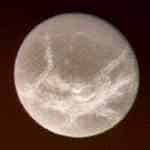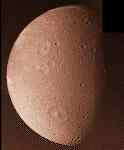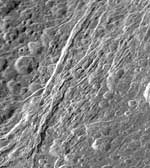Saturn IV
Dione ( “dy OH nee” ) is the twelfth of Saturn’s known satellites:
orbit: 377,400 km from Saturn
diameter: 1120 km
mass: 1.05e21 kg
In Greek mythology Dione was the mother of Aphrodite (Venus) by Zeus (Jupiter).
Discovered by Cassini in 1684.
Dione is the densest of Saturn’s moons (aside from Titan, whose density is increased by gravitational compression). It is composed primarily of water ice but must have a considerable fraction of denser material like silicate rock.
Though somewhat smaller, Dione is otherwise very similar to Rhea. They both have similar compositions, albedo features and varied terrain. Both rotate synchronously and have dissimilar leading and trailing hemispheres.


On the trailing hemisphere there is a network of bright streaks on a dark background and few visible craters (left). The streaks overlay the craters, indicating that they are newer.
The leading hemisphere is heavily cratered and uniformly bright (right). Like Callisto, the craters lack the high relief features seen on the Moon and Mercury.
This was interpreted as follows: shortly after its formation Dione was active. Some processes (ice volcanism?) resurfaced much of Dione leaving the pattern of streaks, probably on the whole surface. Later, after the internal activity and resurfacing ceased, a much less intense series of impacts (which left craters too small to be seen in Voyager’s images) occurred. This was concentrated on the leading hemisphere and wiped out the streak patterns but left them intact on the trailing hemisphere.

And as is often the case in science and to the delight of all involved, newer data shows that the previous hypothesis was wrong. Higher resolution images from Cassini clearly show that the streaks are not ice flows but rather a complex network tectonic fractures that are younger than most of the craters (click the image to the left).
Helene orbits in Dione’s leading Lagrange point. The tiny moon Polydeuces (S/2004 S5), discovered by Cassini in 2004, occupies the trailing Lagrange point.
More about Dione
- more images
- from JPL
Helene

Saturn XII
Helene is the thirteenth of Saturn’s known satellites:
orbit: 377,400 km
diameter: 33 km (36 x 32 x 30)
mass: ?
Helene is the name of an Amazon who battled with Achilles.
Discovered by Laques and Lecacheux in 1980 from ground-based observations.
Helene is in Dione’s leading Lagrange point and hence was sometimes referred to as “Dione B”.
More about Helene
- from LANL
Open Issues
- How did Helene come to be in Dione’s Lagrange point? Is it a fragment of an earlier larger body?
- What was the cause of the resurfacing? Why did it leave only albedo features on Dione?
- Why are there so many fewer craters on the trailing hemisphere?
- Why does Dione lack anything like the deep valley on Tethys?
